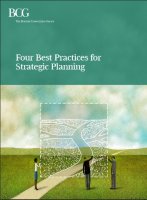
Four Best Practices for Strategic Planning by Nicolas Kachaner, Kermit King and Sam Stewart

Read the summary below and get the key insights in just 10 minutes!

Strategy planning has become an unpopular exercise. Many would much rather go with the flow – which seems to fit these times when today’s innovations are tomorrow’s old hat. Strategy experts Nicolas Kachaner, Kermit King and Sam Stewart from The Boston Consulting Group agree that companies need to be flexible – but recommend having a solid strategy as a base. They describe four characteristics of strategic-planning processes that successful companies have in common. getAbstract recommends this report as a starting point for business leaders looking for ways to kick-start their strategic-planning processes.
[/text_block]

- How successful businesses approach strategic planning,
- How strategic plans should address different time frames, and
- What businesses can do to ensure implementation of their strategic plans.

Each year, almost 10% of public businesses fail. Some argue that, to survive, companies need to be more flexible and do away with strategic planning. However, while it’s true that a company must be agile, a solid strategic grounding is just as important.
“Monthly strategic reviews with the executive committee are critical for fast adaptation and disciplined implementation.”
Successful strategic planning processes share these four characteristics:
“Clearly, long-term vision, medium-term strategy and short-term plans need to be revisited with different frequencies, and those frequencies need to reflect the particulars of the sector.”
- “They explore strategy at distinct time horizons” – Businesses need to look at the long term and scope out the general direction of the company; they need to consider the medium term and define concrete steps toward the company’s vision. Finally, with an eye to the short term, they need to question the strategy and ensure the company is on track.
- “They constantly reinvent and stimulate the strategic dialogue” – Strategy-planning meetings can follow a template process every year, but you should reinvigorate it by asking different questions. Make them neither too specific nor too general. They should help managers broaden their perspectives. To find the right questions, the leadership team could get together to articulate and rank the most crucial issues that the company will be facing in the next three to five years. “Strategic dialogue” should precede “strategic planning.”
- “They engage the broad organization” – Avoid groupthink by allowing a wide range of stakeholders – and even outsiders – to weigh in on strategy. Making people part of the strategy process will increase their commitment to it which facilitates implementation. Including more people will improve the chances of realizing early if you need to adjust your strategy.
- “They invest in execution and monitoring” – Convert plans into manageable, sufficiently “chartered, staffed and resourced” strategic initiatives. Ensure that everyone in the company understands your strategy. Asking managers at all levels to describe the strategy’s implications to their direct reports may be a helpful exercise. Make execution measurable, and provide important players with incentives for reaching quantifiable goals and metrics.
[/text_block]

Nicolas Kachaner, Kermit King and Sam Stewart are strategy experts at the international consulting company The Boston Consulting Group.
[/text_block]

Get key insights from 15,000+ non-fiction books at GetAbstract.com.
[/text_block]




